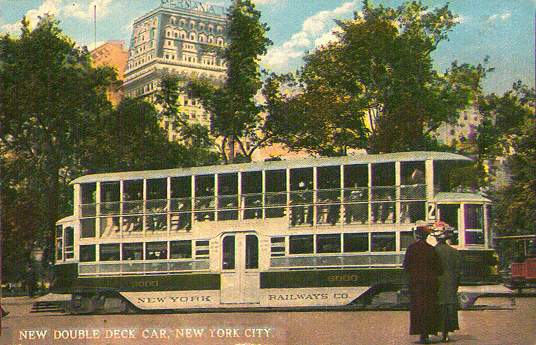

The use of double-deck trams or streetcars was an unusual feature for North American tramways. When it first ran in August 1912, New York Railways Co. car number 6000, was of particular interest.
The car had been designed by Frank Hedley (Vice-President and General Manager of the New York company) and James S. Doyle (the Superintendent of Car Equipment) as a logical development of their single-deck "stepless", or low-floor, trams that had collected the nickname of 'Hobble Skirt' cars (see Postcard). The double-deck bogie car in the view clearly shows the almost road-level central doorway, just 3 inches (75mm) above the ground and indicates the low-floor design that, with a special seating layout, enabled the low-floor to be maintained throughout the passenger area of the lower deck. The upper-deck seating was reached via stairs at either end of the lower saloon (there were none by the centre entrance) and the central longitudinal bench seat can be seen with passengers looking out to the side of the car. The car was convertible and in winter upper deck side panels and drop windows could be fitted. In many ways, the design was way ahead of its time as it is only in recent years that low-floor trams have become common on tramways in parts of the world, especially Europe.
New York 6000 was actually built by the J.G.Brill Company of Philadelphia to Hedley and Doyle's patented design, which had been filed in 1912. The driver's cabs at each end were set higher than the lower-deck passenger area so that the Brill 62E maximum-traction bogies (a modified version of the reversed maximum-traction 39E), arranged close to the car ends, had room to turn. The overall low height of the car (little more than 12 feet, or 4m) was partly due to the fact that central New York operated its trams on the conduit system and not from an overhead wire with trolley-pole pickup. The car was powered by two Westinghouse 310G3 60 h.p. motors and had Westinghouse electro-pneumatic controllers and air brakes.
To those familiar with the London 'Feltham' tramcar of the early 1930s, particularly the centre entrance "Cissie", the general arrangement of car 6000 is remarkably similar (although without the low floor) but pre-dates it by nearly twenty years. Certainly C.S.Spencer, the General Manager of the Metropolitan Electric Tramways in London, visited the US in 1919 and commented on this car in his reports. In 1915 Ludwig Spängler, the General Manager of Vienna's tramways, produced two very similar double-deck cars, possibly inspired by New York 6000.
Car 6000 ran along New York's famous Broadway between South Ferry and 59th Street and thereby earned the nickname of the "Broadway Battleship". In spite of its innovative design, the extra passenger capacity over a similar single-deck car (83 seated, 88 standing), together with having to pass the seated conductor by the entrance, made loading and unloading slow and inconvenient such that it remained a unique tram on the streets of New York until 1922 when it was taken out of service. The only other true double-deck Hedley-Doyle car was supplied by Brill in 1914 to the Colombus Railway Power and Light Company, Ohio, where as car 1000 it ran until 1918.
The American Art Publishing Company and H.Finkelstein & Son of New York City produced this postcard in the summer of 1912 or 1913 showing the car at Union Square. Broadway runs off to the left and right of the view and in the background stands the 21-storey French Renaissance-style Germania Life Insurance Co. building, which was completed in 1911 on East 17th Street. This building, largely unchanged on the outside, is now the "New York W Hotel".
![]() Go to Postcard Of The Month Index
Go to Postcard Of The Month Index